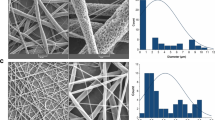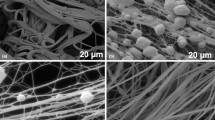Abstract
In the present work, polylactic acid (PLA), elastin and gelatin fibers, containing clindamycin, were prepared to test their potential application as wound dressings. They underwent release studies to determine the mechanism of drug release through mathematical models. The fibers have a homogeneous morphology, without pores. The studies of FTIR and thermal analysis corroborate the presence of each of the components in the fibers; the results of the feasibility tests showed encouraging percentages with a viability of 82% after 7 days of direct contact of the HUVEC cells with the membranes. Similarly, cell adhesion assays show the presence of viable and stretched cells on the fibers, the tendency of the cells to position themselves on the fibers and follow this conformation was observed. On the other hand, studies of antimicrobial activity against S. aureus show us that in fibers loaded with clindamycin they have inhibition halos greater than 8 mm.












Similar content being viewed by others
Data availability
The raw/processed data required to reproduce these findings cannot be shared at this time due to technical or time limitations.
References
Vallianou NG, Stratigou T, Tsagarakis S (2018) “Microbiome and diabetes: where are we now ? Diabetes Res Clin Pract 146:11–118. https://doi.org/10.1016/j.diabres.2018.10.008
Egan AM (2018) What is diabetes ? key points. Medicine 47:1–4. https://doi.org/10.1016/j.mpmed.2018.10.002
Hinchliffe RJ (2019) Foot complications in patients with diabetes. Surg 37:106–111. https://doi.org/10.1016/j.mpsur.2018.12.003
Craven M, Simons Z, De Groot M (2019) Diabetes distress among healthcare providers: a qualitative study. Diabetes Res Clin Pract 150:211–218. https://doi.org/10.1016/j.diabres.2019.03.018
Parsa S, Aghamohammadi M, Abazari M (2019) “SC”, Diabetes Metab. Syndr Clin Res Rev 13:1275–1279. https://doi.org/10.1016/j.dsx.2019.02.007
Ye K, Liu D, Kuang H, Cai J, Chen W, Sun B, **a L, Fang B, Morsi Y, Mo X (2019) Three-dimensional electrospun nanofibrous scaffolds displaying bone morphogenetic protein-2-derived peptides for the promotion of osteogenic differentiation of stem cells and bone regeneration. J Colloid Interf Sci 15:625–636. https://doi.org/10.1016/j.jcis.2018.09.071
Foraida ZI, Kamaldinov T, Nelson DA, Larsen M, Castracane J (2017) Elastin-PLGA hybrid electrospun nanofiber scaffolds for salivary epithelial cell self-organization and polarization. Acta Biomater 62:116–127. https://doi.org/10.1016/j.actbio.2017.08.009
** G, He R, Sha B, Li W, Qing H, Teng R, Xu F (2018) Electrospun three-dimensional aligned nanofibrous scaffolds for tissue engineering. Mater Sci Eng C 92:995–1005. https://doi.org/10.1016/j.msec.2018.06.065
He FL, Li D, He J, Liu Y, Ahmad F, Liu Y, Deng X, Ye Y, Yin D (2018) A novel layer-structured scaffold with large pore sizes suitable for 3D cell culture prepared by near-field electrospinning. Mater Sci Eng C 86:18–27. https://doi.org/10.1016/j.msec.2017.12.016
Gutiérrez-Sánchez M, Escobar-Barrios VA, Pozos-Guillén A, Escobar-García DM (2019) RGD-functionalization of PLA/starch scaffolds obtained by electrospinning and evaluated in vitro for potential bone regeneration. Mater Sci Eng C 96:798–806. https://doi.org/10.1016/j.msec.2018.12.003
Ye K, Liu D, Kuang H, Cai J, Chen W, Sun B, **a L, Fang B, Morsi Y, Mo X (2019) Three-dimensional electrospun nanofibrous scaffolds displaying bone morphogenetic protein-2-derived peptides for the promotion of osteogenic differentiation of stem cells and bone regeneration. J Colloid Interface Sci 534:625–636. https://doi.org/10.1016/j.jcis.2018.09.071
Hall I, Paladino E, Szabó P, Brozio S, Hall P, Oseghale C, Passarelli M, Moung S, Black R, Wilson C, Zelkó R, Lamprou D (2017) Electrospun collagen-based nanofibres: a sustainable material for improved antibiotic utilisation in tissue engineering applications. Int J Pharm 531:67–79. https://doi.org/10.1016/j.ijpharm.2017.08.071
Séon-Lutz M, Couffin AC, Vignoud S, Schlatter G, Hébraud A (2019) Electrospinning in water and in situ crosslinking of hyaluronic acid/yclodextrin nanofibers: Towards wound dressing with controlled drug release. Carbohydr Polym 207:276–287. https://doi.org/10.1016/j.carbpol.2018.11.085
Liu X, Yang Y, Yu D, Zhu M, Zhao M, Williams G (2019) Tunable zero-order drug delivery systems created by modified triaxial electrospinning. Chem Eng J 356:886–894. https://doi.org/10.1016/j.cej.2018.09.096
Yang G, Li J, Yu D, He M, Yang J, Williams G (2017) Nanosized sustained-release drug depots fabricated using modified tri-axial electrospinning. Acta Biomater 53:233–241. https://doi.org/10.1016/j.actbio.2017.01.069
Kabay G, Meydan A, Can G, Demirci C, Mutlu M (2017) Controlled release of a hydrophilic drug from electrospun amyloid-like protein blend nanofibers. Mater Sci Eng C 81:271–279. https://doi.org/10.1016/j.msec.2017.08.003
Tan Y, Lao L, **ong G, Venkatraman S (2018) Controlled-release nanotherapeutics: State of translation. J Control Release 284:39–48. https://doi.org/10.1016/j.jconrel.2018.06.014
Chen S, Li R, Li X, **e J (2018) Electrospinning: An enabling nanotechnology platform for drug delivery and regenerative medicine. Adv Drug Deliv Rev 132:188–213. https://doi.org/10.1016/j.addr.2018.05.001
Zhua L-F, Chena X, Ahmadc Z, Lia JS, Changa MW (2019) Engineering of Ganodermalucidum polysaccharide loaded polyvinyl alcohol nanofibers for biopharmaceutical delivery. J Drug Deliv Sci Tec 50:208–216. https://doi.org/10.1016/j.jddst.2019.01.032
Aadil K, Nathani A, Sharma Ch, Lenka N, Gupta P (2019) Investigation of poly(vinyl) alcohol-gellan gum based nanofiber as scaffolds for tissue engineering applications. J Drug Deliv Sci Tec 54:101276. https://doi.org/10.1016/j.jddst.2019.101276
Yan E, Jiang J, Yang X, Fan L, Wang Y, An Q, Zhang Z, Lu B, Wang D, Zhang D (2020) pH-sensitive core-shell electrospun nanofibers based on polyvinyl alcohol/ polycaprolactone as a potential drug delivery system for the chemotherapy against cervical cancer. J Drug Deliv Sci Tec 55:101455. https://doi.org/10.1016/j.jddst.2019.101455
Pankongadisaka P, Sangklina S, Chuysinuanb P, Suwantonga O, Supaphold P (2019) The use of electrospun curcumin-loaded poly(L-lactic acid) fiber mats as wound dressing materials. J Drug Deliv Sci Tec 53:101121. https://doi.org/10.1016/j.jddst.2019.06.018
Zhang D, Lia L, Shan Y, **ong J, Hu Z, Zhang Y, Gaoa J (2019) In vivo study of silk fibroin/gelatin electrospun nanofiber dressing loaded with astragaloside IV on the effect of promoting wound healing and relieving scar. J Drug Deliv Sci Tec 52:272–328. https://doi.org/10.1016/j.jddst.2019.04.021
Bhardwaj N, Kundu SC (2010) Electrospinning: A fascinating fiber fabrication technique. Biotechnol Adv 28:325–347. https://doi.org/10.1016/j.biotechadv.2010.01.004
Tian D, He JH (2018) Macromolecular electrospinning: Basic concept and preliminary experiment. Results Phys 11:740–742. https://doi.org/10.1016/j.rinp.2018.10.042
Haider A, Haider S, Kang IK (2018) A comprehensive review summarizing the effect of electrospinning parameters and potential applications of nanofibers in biomedical and biotechnology. Arab J Chem 11:1165–1188. https://doi.org/10.1016/j.arabjc.2015.11.015
Topuz F, Uyar T (2019) Electrospinning of nanocomposite nanofibers from cyclodextrin and laponite. Compos Commun 12:33–38. https://doi.org/10.1016/j.coco.2018.12.002
Hu X, Liu S, Zhou G, Huang Y, **e Z, **g X (2014) Electrospinning of polymeric nanofibers for drug delivery applications. J Control Release 185:12–21. https://doi.org/10.1016/j.jconrel.2014.04.018
Cisquella-Serra A, Magnani M, Gual-Mosegui Á, Holmberg S, Madou M, Gamero-Castaño M (2019) Study of the electrostatic jet initiation in near-field electrospinning. J Colloid Interface Sci 543:106–113. https://doi.org/10.1016/j.jcis.2019.02.041
Lim L-T, Mendes AC, Chronakis IS (2019) Electrospinning and electrospraying technologies for food applications. Elsevier Inc., New York
Kyselica R, Enikov ET, Anton R (2019) Electrospinning under lateral electrostatic control in ambient atmosphere. J Electrostat 98:75–81. https://doi.org/10.1016/j.elstat.2019.02.006
Soares R, Siqueira N, Prabhakaram M (2018) Electrospinning and electrospray of bio-based and natural polymers for biomaterials development. Mater Sci Eng C 92:969–982. https://doi.org/10.1016/j.msec.2018.08.004
Aydogdu A, Yildiz E, Ayhan Z, Aydogdu Y, Sumnu G, Sahin S (2019) Nanostructured Poly(lactic acid)/Soy Protein/HPMC films by electrospinning for potential applications in food industry. Eur Polym J 112:477–486. https://doi.org/10.1016/j.eurpolymj.2019.01.006
Kalantari K, Afifi AM, Jahangirian H, Webster TJ (2019) Biomedical applications of chitosan electrospun nanofibers as a green polymer – Review. Carbohydr Polym 207:588–600. https://doi.org/10.1016/j.carbpol.2018.12.011
Aguirre-chagala YE, Altuzar V, León-sarabia E, Tinoco-magaña JC, Yañez-limón JM, Mendoza-barrera C (2017) Physicochemical properties of polycaprolactone/collagen/elastin nano fi bers fabricated by electrospinning. Mater Sci Eng C 76:897–907. https://doi.org/10.1016/j.msec.2017.03.118
Alharbi HF, Luqman M, Fouad H, Khalil KA, Alharthi NH (2018) Viscoelastic behavior of core-shell structured nanofibers of PLA and PVA produced by coaxial electrospinning. Polym Test 67:136–143. https://doi.org/10.1016/j.polymertesting.2018.02.026
Chen P, Liu L, Pan J, Mei J, Li C, Zheng Y (2018) Biomimetic composite scaffold of hydroxyapatite/gelatin-chitosan core-shell nano fibers for bone tissue engineering. Mater Sci Eng C 97:325–335. https://doi.org/10.1016/j.msec.2018.12.027
Merkle V, Tran P, Hutchinson M, Ammann K, DeCook K, Wu X, Slepian M (2015) Core–shell PVA/gelatin electrospun nanofibers promote human umbilical vein endothelial cell and smooth muscle cell proliferation and migration. Acta Biomater 27:77–87. https://doi.org/10.1016/j.actbio.2015.08.044
Puchalski M, Kwolek S, Szparaga G, Chrzanowski M, Krucinska I (2017) Investigation of the Influence of PLA Molecular Structure on the Crystalline Forms (α’ and α) and Mechanical Properties of Wet Spinning Fibres. Polymers 9:1–13. https://doi.org/10.3390/polym9010018
Kierzkowska M, Majewska A, Szymanek-Majchrzak K, Sawicka- Grzelak A, Mlynarczyk A, Mlynarczyk G (2018) In Vitro Effect of Clindamycin against Bacteroides and Parabacteroides Isolates in Poland. J Glob Antimicrob Resist 13:49–52. https://doi.org/10.1016/j.jgar.2017.11.001
Amjadi S, Emaminia S, Heyat Davudian S, Pourmohammad S, Hamishehkar H, Roufegarinejad L (2019) Preparation and characterization of gelatin-based nanocomposite containing chitosan nanofiber and ZnO nanoparticles. Carbohydr Polym 216:376–384. https://doi.org/10.1016/j.carbpol.2019.03.062
Takeru H (1961) Rate of release of medicaments from ointment bases containing drugs in suspension. J Pharm Sci 50:874–875. https://doi.org/10.1002/jps.2600501018
Peppas N, Gurny R, Doelker E, Buri P (1980) Modelling of drug diffusion through swellable polymeric systems. J Membr Sci 7:241–253. https://doi.org/10.1016/S0376-7388(00)80471-8
Peppas N, Colombo P (1997) Analysis of drug release behavior from swellable polymer carriers using the dimensionality index. J Control Releas 45:35–40. https://doi.org/10.1016/S0168-3659(96)01542-8
Bonilla-Hernández M, Zapata-Catzin GA, Castillo-Cruz OD, Vargas-Coronado RF, Cervantes-Uc JM, Xool-Tamayo JF, Borges-Argaez R, Hernández-Baltazar E, Cauich-Rodríguez JV (2021) Synthesis and characterization of metformin-pluronic based polyurethanes for controlled drug delivery. Int J Polym Mater Polym Biomater 70(9):656–667. https://doi.org/10.1080/00914037.2020.1740996
González-Pérez J, Vargas-Arispuro I, Aispuro-Hernández E, Aguilar-Gil C, Aguirre-Guzmán Y, Castillo A, Hernández-Mendoza A, Ayala-Zavala JF, Martínez-Téllez M (2019) Potential Control of Foodborne Pathogenic Bacteria by 0Pediococcus pentosaceus and Lactobacillus graminis Isolated from Fresh Vegetables. Microbiol Biotechnol Lett 47:183–194. https://doi.org/10.4014/mbl.1808.08014
Sangnim T, Limmatuapirat S, Nunthanid J, Sriamornsak P, Sttikijyothin W, Wannachaiyasit S, Huanbutta K (2018) Design and characterization of clindamycin-loaded nanofiber patches composed of polyvinyl alcohol and tamarind seed gum and fabricated by electrohydrodynamic atomization. Asian J Pharm Sci 13:450–458. https://doi.org/10.1016/j.ajps.2018.01.002
Patel P, Patel P (2015) Formulation and evaluation of clindamycin HCL in situ gel for vaginal application. Int J Pharm Investig 5:50–56. https://doi.org/10.4103/2230-973X.147233
Silva R, Singh R, Sarker B, Papageorgiou D, Juhasz-Bortuzzo J, Cicha J, Kaschta J, Schubert D, Chrissafis K, Detsh R, Boccaccini A (2018) Hydrogel matrices based on elastin and alginate for tissue engineering applications. Int J Biol Macromol 114:614–625. https://doi.org/10.1016/j.ijbiomac.2018.03.091
Zhou Y, Lei L, Yang B, Li J, Ren J (2018) Preparation and characterization of polylactic acid (PLA) carbon nanotube nanocomposites. Polym Test 68:34–38. https://doi.org/10.1016/j.polymertesting.2018.03.044
Author information
Authors and Affiliations
Corresponding author
Additional information
Publisher's Note
Springer Nature remains neutral with regard to jurisdictional claims in published maps and institutional affiliations.
Rights and permissions
About this article
Cite this article
Castillo-Ortega, M.M., López-Peña, I.Y., Rodríguez-Félix, D.E. et al. Clindamycin-loaded nanofibers of polylactic acid, elastin and gelatin for use in tissue engineering. Polym. Bull. 79, 5495–5513 (2022). https://doi.org/10.1007/s00289-021-03734-6
Received:
Revised:
Accepted:
Published:
Issue Date:
DOI: https://doi.org/10.1007/s00289-021-03734-6




